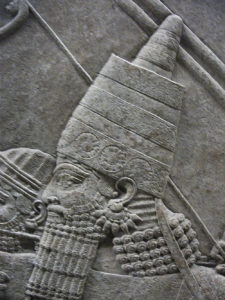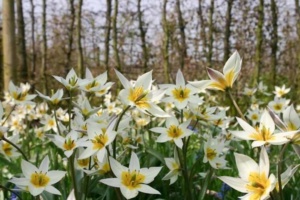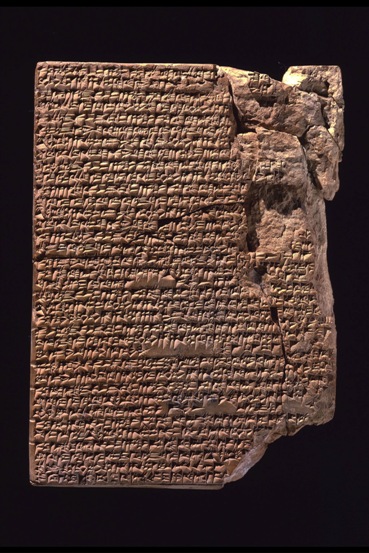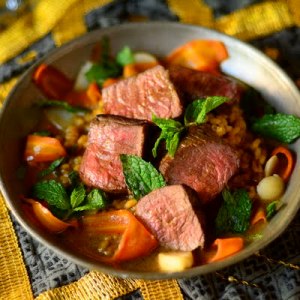Imagine for a moment you are at a royal banquet. It is an Assyrian royal banquet in the seventh century BCE. It is a large dining hall in the palace at Nineveh draped with fabric and decorated for the celebration. Smoke and incense perfume the room. Music fills the air. Quiet pieces have harps, lyres or lutes and perhaps pipes accompanying singers or poets and in louder pieces, trumpet blaze and drums pound to rile the blood while dancers leap. Beer and (by this time) wine from grapes and other fruits flows freely.

Presiding over the feast is Assyrian King Ashurbanipal, a learned man and to his peoples, a benevolent ruler. An example of what some swarthy, southern seafarer would someday call a philosopher king. On military and diplomatic missions he has men collect plants, seeds, animals, or anything unusual from the foreign lands they pass through. Upon returning they are placed in palace gardens, zoos and rooms filled with curiosities that predate the Tradescantium by more than two-thousand years. In this manner, he honors his ancestor Assurnasirpal II and his palace garden at Kahlu (known these days as the hanging gardens of Babylon (probably)).
Ashurbanipal is a man of letters who can read and speak several modern and ancient languages. He is a sponsor of the arts and sciences who has teams of artists, astronomers and mathematicians as part of his court. He has also rebuild and restored temples and buildings weakened by war or the simple ravages of time. But by far his greatest achievement is the systematic gathering of knowledge and the cataloging of it in the first organized, modern library in the western world. The library is a royal archive but also contains treatises on medicine and science, divination, as well as folktales, and some favorite recipes. He doesn’t know it yet, but it is because of him that the tales of Gilgamesh and a great deal of knowledge about his world survived.
He is a great king and tonight’s banquet is a special meal to celebrate ascension of Assyrian appointed Egyptian ruler, Necho I, a native administrator who pledged his peace and tribute to Nineveh. As you reflect on the greatness of the king, the woman next to you stirs anxiously and her dark red linen tunic crinkles slightly against her fine cotton shawl and her gold earrings softly jingle as she moves. She is hungry and so are you. Just in time, drums roll and Assurbanipal stands flanked by his priests and asks the favor of Ellil and Ishtar in both his celebration and Egyptian campaign. When the gods’ blessings have been received, teams of servants sweep in and place food on the tables. One by one the dishes you have waited all afternoon for are revealed: mutton broth with onions, vegetable broth with garlic and leeks, a broth of made with wildfowl, roasted onions, onion porridge and flatbread. Hmmm . . . Not a feast fit for a king.
That is the food that the Yale Babylonian Recipe Tablets suggest were eaten at royal banquets – at least according to the translations of Jean Bottero. Writing in Textes Culinaires Mesopotamien (TCM) and the English language Oldest Cuisine in the World (OCW), Bottero translates recipes for 21 meat broths and four vegetable broths from the first of the three tablets – Tablet A. Tablets B and C are recipes for different types of fowl for both culinary use and for use as religious offerings.
My own ongoing research available on the Silk Road Gourmet website suggests that many of Bottero’s translations were wrong or rather that the analysis of the evidence from the Yale tablets and supporting sources led him to misdefine or leave undefined many ingredients. His other errors include disagreeing without explanation or ignoring existing scholarship on plants and animals that would have allowed him to fill in his untranslatable words; and analyzing the ingredients and dishes though a French haute-cuisine lens instead of a modern regional one. Above all, onions rule the culinary pantheon, at least according to Bottero.
So, if not onions, then what?

First of all, the “onion” described in the texts is flavorwise probably more like a mild shallot than the bitter, mass produced bulbs we call onions today. My research has shown that suhutinnu is probably a carrot or possibly a parsnip; andahsu is likely a wild tulip or wild crocus or lily bulb, and samidu isn’t an onion or even another sort of vegetable at all, but rather semolina. Pistachio nuts, carob seeds, roasted dill seed, wild licorice, juniper berries and date-plums are other ingredients that I believe Bottero got wrong or left undefined in the face of existing scholarship. Lastly, siqqu isn’t a fish sauce (garum) like the Carthaginians and later the Romans produced, it is rather salted fish or other salted meat, probably consumed with a splash of fruit vinegar and some sweet fruits like dates or date-plums.
In addition to scholarly arguments about translating a few cuneiform tablets, linguistic sources and representational art shows a rich Mesopotamian culinary culture. Fruits ranged from pomegranates and dates to apricots, apples, pears and in the neo-Assyrian period possibly bananas. In addition to those already mentioned, vegetables included radish, beets and lettuce. Sheep and goats were consumed when older and their fat harvested, but they were primarily used as milk producers when young. Other meat came from cattle, bison and oxen as well as from wild game. Wild and domesticated and fowl and fish of many sorts were enjoyed and a wide variety of milk products, from butter and cheese to yogurt and sour cream were also eaten. Furthermore, the kingdom waxed and waned over the centuries but at different times included the area from Anatolia and Egypt, Syria, and Jordan in the west and south and into parts of Iran to the east and south. A bountiful harvest was to be had both at home and from abroad through trade of ingredients and culinary knowledge as well as the flow of people throughout the empire.
Is broth all there is?
I don’t think that any of the recipes translated by Bottero are broths. Rather, they are general guidelines for the flavors of dishes that range from koreshes, curries and soups to braised meats and dry pilafs – it all depends on the relative proportions of liquid and solid ingredients. Amounts of ingredients are almost always absent, so the exact dish prepared is left up to the cook.

In the west, many cooks are more than a little uncomfortable with this amount of variation in a “recipe”, but a great deal of the rest of the world still cooks with this amount of flexibility. Take for example, Kishk, the wheat and fermented milk/yogurt preparation enjoyed throughout western Asia, the Levant and parts of North Africa. The basic kishk is either “green” in the form of a moist, kneadable ball, or dry in the form of flour, or somewhere in between. Additionally, it can be made into a dessert with the addition of milk, sugar and nuts, or a cheese like preparation flavored with herbs and preserved in olive oil in Lebanon, or a stew in Egypt with onions, garlic, meat and yogurt. Interestingly, this final combination is a commonly used in the Yale Babylonian (shallots and garlic or leeks pounded with kishk) recipes to form a rich and flavorful ground for the meat and other ingredients.
So, what do the tablets say?
O.K., O.K. I’m getting to it. . . Some of the flavors represented are incredibly exotic and intriguing. In addition to the Lamb and Wild Licorice Stew I identified in a previous post on the subject of Mesopotamian food on my site, the flavors on Tablet A in the Yale Babylonian culinary collection include:
Recipe XIX: Lamb or Beef with Carob – Prepare water with fat, salt, shallots and semolina. Mash garlic and leeks with yogurt or sour cream. Crush carob seeds. Assemble ingredients in a pot.
(In this and other recipes, the type of fat is unknown, it could be butter, or some type of animal fat or even a vegetable or nut oil. Also, the disposition of the dairy product is unknown. They could be moist like a yogurt or sour cream or partially dried like a chaka or even completely dried like kashk.)
Recipe XX: Mutton with Wild Licorice and Juniper – (Mutton shank is used). Prepare water, fat and licorice root. Add salt, juniper, shallots, semolina, cumin and coriander. Mash the garlic and leeks with yogurt or sour cream.
(The biggest uncertainties here are whether the cumin should be seeds or ground, or whether the coriander should be seeds, ground or the herb cilantro.)
Recipe XXII: Lamb with Beets and Bran – Prepare water and fat. Add salt, beer, shallots, arugula, coriander, semolina, cumin and the peeled beets. Add mashed leeks and garlic. Finish with coriander and carrot or parsnip.
(In this recipe, bran may actually be bulgur wheat. My best guess is that the most likely finish is cilantro and finely sliced or shredded carrots. If bulgur is tried, I think that this could be a delicious pilaf.)
Recipe XXIII: Lamb with Barley with Mint – (Lamb shank is used). Prepare water, add fat and barley. Add semolina, coriander, cumin and yogurt or sour cream. Assemble in the cooking vessel and sprinkle with crushed garlic. Then blend in carrots or parsnips and mint.
(I think the garlic is probably diced or minced, not crushed – unless “sprinkle” is not quite the right verb.)
I have yet to cook these recipes, but hope to soon. If you are the adventurous sort and wish to experiment around with them, please do! If you do, please also let me know how your cooking (and tasting) experience went. As to the recipes on Tablets B and C a couple of them look very interesting and seem to include a fowl pie – or birds enclosed in a crust; and perhaps a stew on a large flatbread – sort of like the presentation used with Ethiopia’s injera. I need to research these a bit more and will blog about them back at my own site at some future time.
Now, if I were a guest at Ashurbanipal’s banquet – I’d tuck into the Lamb or Beef with Carob first. Maybe I’d make that the Mutton with Licorice and Juniper, or the Lamb with Beets and Bran . . . For dessert, if I had room, I’d pop a few mersu (pounded dates rolled in pistachio nuts and sliced into bite-size confections) for dessert with another sip of fruit wine before bidding my companions farewell for the evening.
Now over, that banquet was one of many in his kingdom made wealthy by tribute from afar. But his peace and prosperity was not to last, for Assurbanipal was the last great king to rule Assyria before it was conquered first by Babylon and then a few hundred years later by a tiny but fierce upstart from Macedonia. (Words and analysis by Laura Kelley. Special thanks to Deana for inviting me to guest post!)
Deana’s note: I made this delicious dish as soon as I got back, taking some liberties with the 4000 year old recipe. You can stick to the original if you would like, but I gotta say… this is really good!
Lamb with Barley and Mint, XXIII
(this is Deana’s version of the dish, and the featured photo for the post)
Ingredients
2 boneless lamb steaks (about 1 pound), trimmed, retaining the trimmings
1 T soy sauce (preferably shoyu – I used murri sauce which I brewed from a 1000 year old recipe that I will share with you soon… it is THAT GOOD)
1 T olive oil (although many old recipes use sesame oil— not the roasted kind)
1 t ground cumin
1 t ground coriander
1/4 t black pepper
2 cloves garlic
1 cup barley
4 c stock (lamb, beef or chicken)
1 c yogurt ( I used the cream on top kind and used the cream layer)
4 carrots
1/2 c chopped mint
4 carrots, cut into ribbons with a vegetable peeler
Directions
Marinate the lamb in the soy sauce for 1/2 an hour. Sauté the lamb in the oil. Remove the large pieces and leave the trimmings in the pot. Stir the barley into the oil and toast for a few moments. Add the spices, garlic. Simmer for 30 minutes until the barley is cooked. Place the lamb steaks in the pan and warm… cooking to desired degree of doneness (I like mine RARE so I only put them in for 5 mintues).
Add the carrots for 5 minutes, sprinkled over the top. There should be a lovely sauce. Remove the lamb (leave the trimmings out of the dish) and let rest for 5 minutes, then slice.
Place the carrots in the dish, spoon the barley over carrots, add the sliced lamb and sprinkle with mint.

